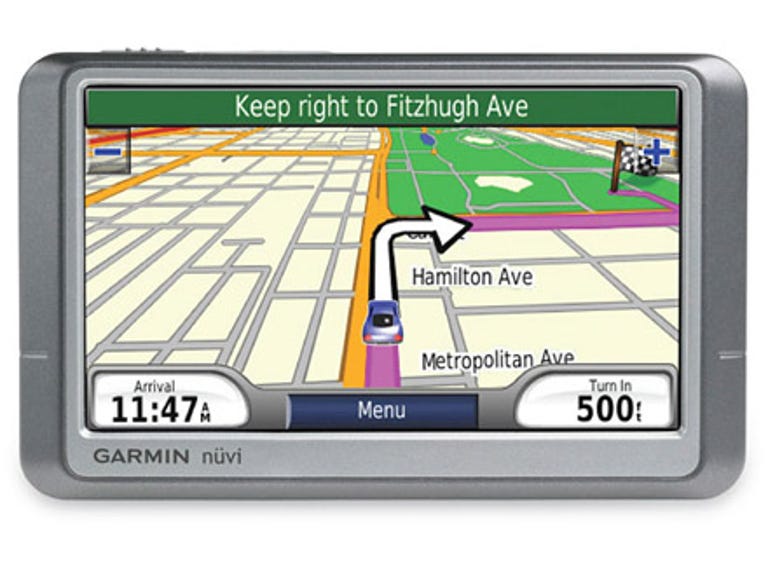 Why You Can Trust CNET
Why You Can Trust CNET Garmin Nuvi 260W review: Garmin Nuvi 260W
A good, easy to use GPS, with great verbal speed and red light camera warnings which, unfortunately, aren't installed by default.
Design
With its mix of dark grey plastic and silver finish for its screen bezel the Garmin Nuvi 260W is a pleasant looking, if not particularly outstanding, GPS unit. Initially we had trouble distinguishing it from the more expensive Nuvi 760 that we were testing at the same time. There's a 4.3-inch touchscreen — there's also a cheaper 260 sans W suffix that features a smaller 3.5-inch screen — that drives all of the unit's functions bar power, which is controlled by a dimpled slider switch on the top left corner of the device. Out the back there's a moderately sized speaker which has a good volume range — from mouse quiet to Denis the Sadistic Nut loud — but tends to crackle a little when the volume is cranked up.
The Good
The Bad
The Bottom Line
Although not without its quirks, the Garmin's interface is a generally snap to use. Once the device has been booted up, and you've whizzed past the safety warning replete with American legalise, you're presented with the main menu featuring two large icons "Where To?" and "View Map", as well as two smaller icons for the configuration and volume screens. Entering destinations is hampered by the fact that there's no option to change from the ABC on-screen keyboard to the QWERTY system we're more familiar with. If you've dived deep into the menu system, it can take quite a few clicks to get back out to the map display — annoying, and potentially dangerous, if you have the need to fiddle with settings at the traffic lights.
Our other gripe centres around the map display that by default will omit some streets and details. This leads to streets popping in and out of view as you're driving along, making it difficult to determine how many streets away your next turn is. Upgrading the unit's firmware via PC or bumping up the detail level up to maximum fixed that problem. The latter also works around the issue of streets suddenly disappearing when you arrive at your destination.
The map screen is uncluttered with next turn instructions along the top, and a bar down the bottom featuring a Menu button, current speed/arrival time and compass heading. Clicking the speed/arrival time display reveals stats on the current trip, clicking the either compass direction or turn instruction brings up the various views of the turn-by-turn instructions.
Setting the 260W up in the car is a simple affair: there's a small cradle that snaps onto the back of the Garmin, into which you insert the compact windshield mount. The mount's ball joint allows the screen's viewing angle to be adjusted easily, while the levered suction cup sticks like a limpet to the windscreen but is also easy to remove for storage.
Features
Seeing as Garmin has denied 260W owners of an on-screen QWERTY keyboard, it's not surprising to see a fairly bare features list. There's text-to-speech, which reads out street names in turn instructions, but no Bluetooth hands-free. We like Garmin's red light and speed camera warnings except for one thing, they're not preloaded on the device — a real shame for a device being marketed on its ease of use.
To get these warnings you'll have to go to Garmin's website, find the special Points of Interest (POI) files and install them onto the 260W. Finding these files is a far from trivial exercise — there's no link from the home page, for instance — so, if you already own a Garmin device, check out our step-by-step guide on installing Garmin's speed and red light camera warnings.
Performance
Once installed you'll get some underwhelming visual markers on the map — a red dot for red light cameras, a camera icon for speed cameras — but also some great audible alerts. Instead of the generic chime that most GPS makers opt for, Garmin uses a verbal alert, such as "red light camera ahead" and "40km school zone ahead". However, the pre-recorded male voice used for these alerts can be a bit of a shock at first if you're using a female voice for spoken instructions.
Starting up the 260W takes a languorous 24 seconds which, when coupled with the sometimes lengthy wait for satellite lock on, can mean speedy getaways are difficult to do. At times the 260W selected routes more circuitous than we're used to from GPS navigation devices, but otherwise it's generally the same old deal with satellite navigation performance. As expected the 260W's usefulness in guiding you around downtown is marred by bounced satellite signals which often leads the Garmin to think it's on a dank, dark city alleyway instead of cruising down a thoroughfare.
And, as is the norm, routes are far from optimal but they'll get you to your destination. More annoying, however, is the inability to specify roads or areas to avoid; the best that can be done is ask for a detour, which may or may not have the desired affect, or ignore the 260W for a while and wait for it to re-route you along a more sane route.
Overall
In ease-of-use terms the Garmin loses in a points decision with TomTom's, primarily because of the missing QWERTY keyboard and the safety camera warnings which have to be loaded manually. At the RRP we'd still plump for TomTom's second generation XL — thanks to its user map correction and sexier design — but you won't cry tears of pain if you go with the 260W instead.


